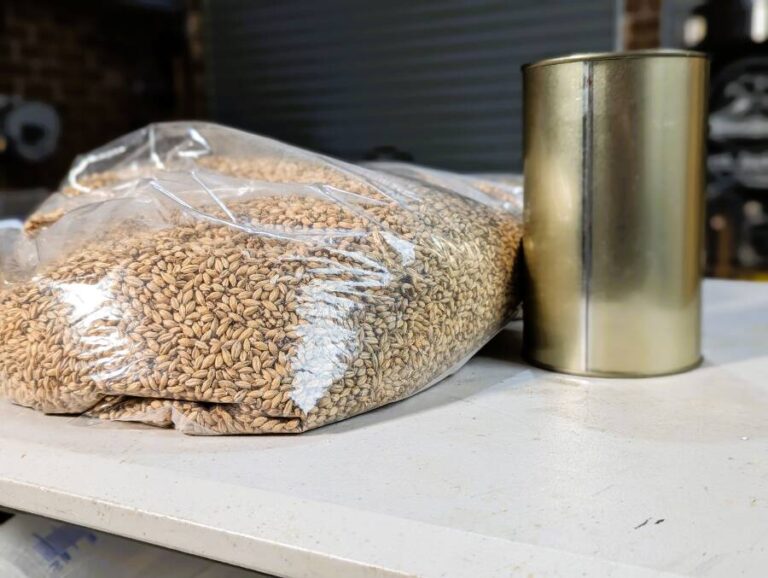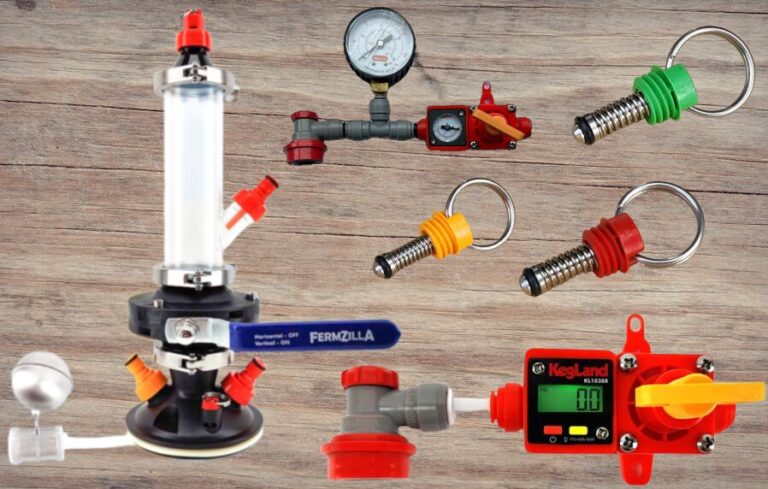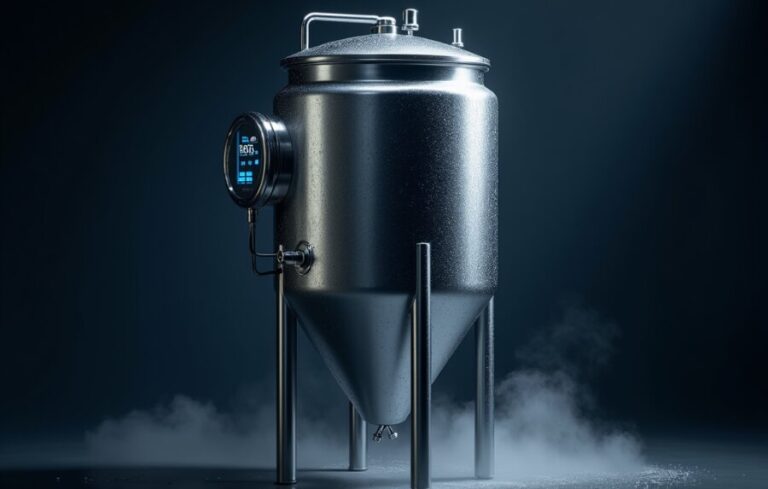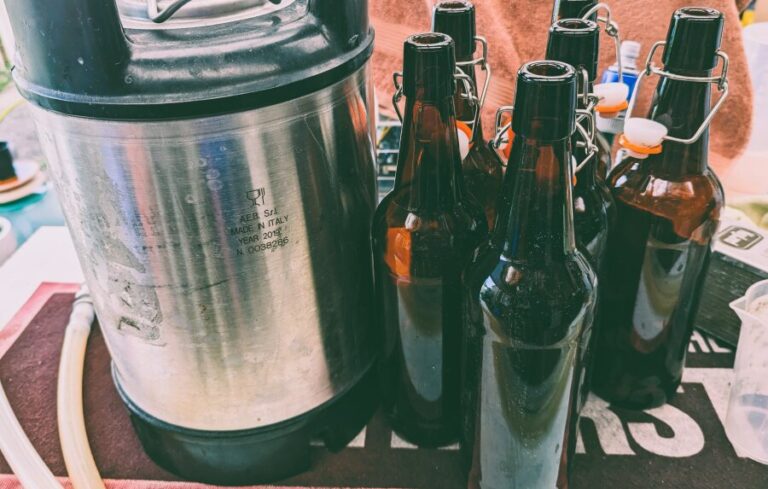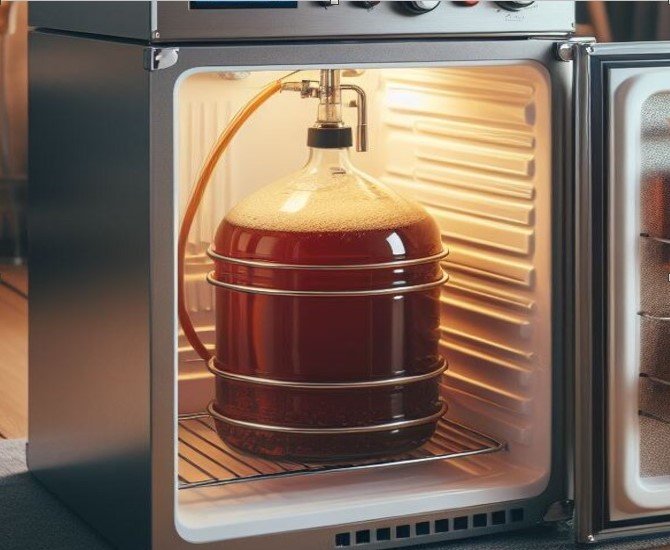Our evaluations and product assessments are conducted using a thorough and unbiased approach. Should you choose to buy any items through our provided links, we might receive a commission Read our disclosures.
They often say that success is mostly preparation with a sprinkle of inspiration. This rings true in the world of homebrewing. Let’s dive into the basics of crafting your own beer with a quick break down of the process followed by a list of home brewing beer equipment and ingredients you’ll need to start.
The process starts with simmering malt, hops, and water, which melds into a sweet, grain-infused concoction.
Following this, we introduce yeast, a type of fungus, to the brew, known as wort. With some patience, this mixture transforms into a tepid, non-carbonated beverage.
The final step involves combining your home brew with a small amount of sugar before sealing it in bottles. This mixture then naturally carbonates, leaving you with effervescent beer ready to enjoy in a fortnight. Alternatively, you can choose kegging for your beer. This process involves transferring the homebrew directly from the fermenter into the keg and then carbonating it using CO2.
Every piece of equipment that will touch your beer needs to be meticulously cleaned. Additionally, right before you use them, these items require sanitization. While your brew kettle is exempt from sanitization due to the sterilizing power of boiling wort, it still demands a good scrub to be ready for action.
Home Brewing Beer Equipment and Ingredients:
- Sanitizer: Essential for maintaining sterile brewing tools.
- Brew Kettles or Boiler: The cauldrons for boiling your brew’s foundation, the wort.
- Fermenters: Your beer’s transformation chamber, where the brewing magic happens.
- Airlocks: The guardians that protect your developing brew from unwanted air exposure.
- Stirring Paddle: A brewer’s ally for mixing and safeguarding against messy overflows.
- Hydrometer or Refractometer: Measure the gravity of your brew.
- Bottles or Kegs: The final abode for your crafted ale, ready to be enjoyed.
- Wort Siphon: The device that smoothly relocates your brew from one vessel to another.
- Cap Sealers: The trusty gadgets that secure caps onto your bottles, ensuring freshness.
- Bottle Caps: A diverse array of bottle toppers to suit various container styles.
Every beer fundamentally consists of four key components: Grains (usually malted barley), Hops, Yeast, and Water. The simplicity of this ingredient list belies the vast diversity they offer. These elements are the building blocks for the incredible spectrum of beer varieties we enjoy, ranging from light, crisp pilsners to the deepest, richest stouts, and all the unique flavors in between.
While these are the basics, many brewing recipes or kits might also call for additional elements like specialty grains, various sugars, or even spices to enhance the flavor profile. The most essential ingredient, however, is the one you supply: water. The composition of your water can significantly influence the final taste of your brew. As long as your tap water is pleasant to drink, it’s also suitable for brewing your beer.

All About Malt
The journey of crafting beer starts with the sweet essence of malted barley and other grains. The malting process is where the magic begins, as grains are germinated and then swiftly dried to halt growth, unlocking their sugary potential. This step is vital for producing amylase, an enzyme that plays a pivotal role in brewing.
When brewers mash the malt, they’re essentially soaking the crushed grains in hot water, which kick-starts the enzyme activity, turning starches into fermentable sugars. These sugars are then extracted from the grains, creating a liquid called wort. The wort is boiled with hops to add bitterness and flavor, and after it cools down, yeast is added to ferment the brew, resulting in the delightful array of beers we savor.
For newcomers to the brewing scene, mashing might seem like a complex step. That’s where malt extracts come to the rescue. Available in liquid or dry form, these extracts are the concentrated essence of the mashing process, ready for use. Homebrewers can then infuse their concoctions with a touch of specialty grains, usually around one pound, to impart distinct flavors and colors to their homemade beers, bypassing the traditional mashing step.

Hops: The Essence of Beer
The hop plant, known scientifically as Humulus lupulus, is recognized by its distinctive cone-shaped flowers. These are integral to beer production, providing the necessary bitterness to counteract malt’s inherent sweetness and introducing a spectrum of flavors and aromas. Hops play multiple roles in beer making: they are a bittering agent, a flavor and aroma enhancer, a stabilizer against spoilage, a contributor to foam stability, and a natural clarifying agent.
Historically, hops weren’t always part of beer brewing. It was only in the 11th century that their use was recorded in Germany, and it took until the 16th century for British brewers to adopt them widely. Before hops, brewers used a variety of herbs like heather, rosemary, anise, spruce, and wormwood to flavor and preserve their brews—a practice some modern brewers still explore for unique tastes.
Hop varieties are closely tied to specific beer styles and regions, sometimes even defining a brewery’s unique flavor profile. The cultivation of hops has yielded numerous strains, each with its own balance of alpha and beta acids that contribute to beer’s stability and bitterness.
The essential oils in hops, responsible for imparting distinct flavors and aromas, are sensitive to heat. If added early in the brewing process, these oils can evaporate, but when introduced later or post-fermentation, they infuse the beer with notes that can range from grassy to floral, citrusy to spicy, and earthy to flowery.
Available in various forms such as pellets, plugs, or whole leaf, hops are a homebrewer’s staple and can even be cultivated at home for a personal touch to one’s brewing endeavors.

Yeast: A Journey Through Time
In the ancient world, beer was brewed using wild yeast present in the environment. Around 7000 to 6000 BCE, people in ancient Mesopotamia discovered that this mysterious unseen agent could transform sweet liquid into beer. However, it wasn’t until much later that brewers truly understood the role of yeast in the brewing process.
Fast forward to 1516, and we find ourselves in Germany with the Reinheitsgebot, also known as the German Beer Purity Law. This law listed the only allowable ingredients for brewing beer: malt, hops, and water. Interestingly, yeast was conspicuously absent from this list. At that time, yeast remained an enigma—the primary agent of fermentation shrouded in mystery.
Enter the Vikings and their “magic sticks.” These sticks were used to stir beer during the brewing process. Little did they know that these seemingly ordinary sticks carried a precious secret: the family yeast culture. Passed down from generation to generation, these heirlooms played a crucial role in fermenting wort and creating beer. The Vikings unwittingly propagated yeast, ensuring the continuation of their brewing tradition.
Understanding the genetic origins of brewer’s yeast has practical implications for brewers. By unraveling this complex history, they gain insights into domestication processes and the development of novel beer flavors. Whether it’s a hop-forward ale or a crisp lager, yeast plays a pivotal role in shaping the beverage we love.
frequently asked questions related to home brewing beer equipment and ingredients:
- What does a hydrometer do, and why do I need it?
- A hydrometer measures the Specific Gravity (S.G.) of a liquid, indicating the density of sugars. It helps you understand your beer’s progress.
- Take an initial reading (Original Gravity, O.G.) before fermentation. During fermentation, the reading drops as sugars convert to alcohol.
- How can I calculate alcohol percentage using my hydrometer?
- Use this formula: ABV = (OG – FG) × 131.
- For example, if your original gravity (OG) was 1.045 and your final gravity (FG) is 1.010:
- ABV = (1.045 – 1.010) × 131 = 4.56% ABV.
- How do I choose the right hops for my beer?
- Consider the hop variety’s:
- Alpha acids: Affect bitterness.
- Aroma profile: Determines flavor and aroma.
- Purpose: Bittering, flavor, or aroma.
- Consider the hop variety’s:
- What’s the role of yeast in brewing?
- Yeast converts sugars into alcohol and carbon dioxide during fermentation.
- Different yeast strains produce varying flavors and aromas.
- Choose ale yeast for ales and lagers for lagers3.
- How can I ensure proper sanitation during brewing?
- Clean and sanitize all equipment thoroughly.
- Use a no-rinse sanitizer to avoid off-flavors.
- Pay attention to cleanliness during every step of the process.




